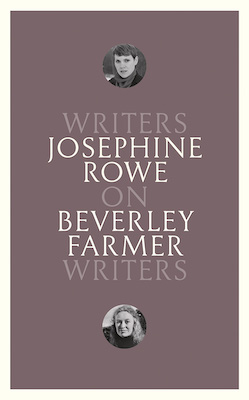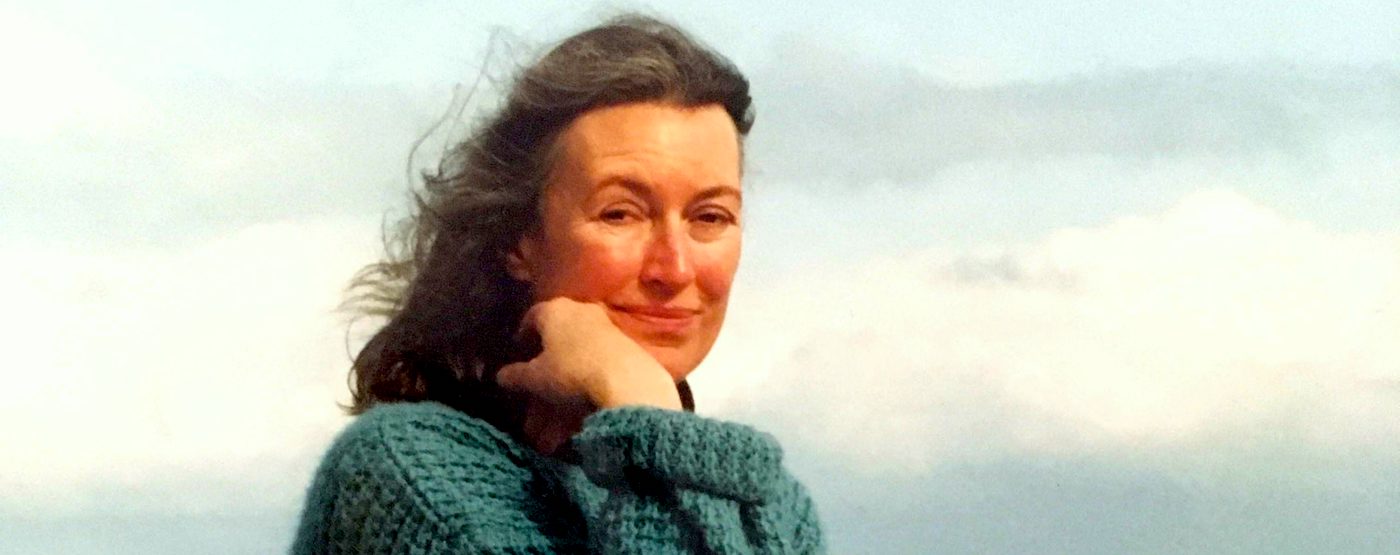Attention to what is. Because whatever is added to the image hoard of one mind is an addition to the world. Not a permanent one, needless to say. What is permanent about a grain of fire in space? We believe in anything rather than accept that a whole world emblazoned inside the eggshell of the skull is fated for extinction.
–Beverley Farmer, The Bone House
*
April in Rome. I was not yet lonely. Still considered myself inoculated against loneliness, having lived out of suitcases for several years, moving through a succession of cities where, for a while at least, no one knew me.
The idea of home was tucked into a few portable articles. A slender stack of books that had become talismanic through travel. Two palm-sized stones from Lake Huron. A painted wooden jewelry box that had belonged to my grandmother. A white gold ring, and another carved from red cedar. Letters from friends that had found me in Montreal, Toronto, Oakland, Hobart, New York. These had taken on a reassuring sense of continuity: You are here, regardless of the postmark. I carried them with me to Italy, though I knew it would only be six months.
In February, shortly after I arrived, it had snowed for the first time in six years, and children who had never seen snow before were let loose on it. Their parents plowed into it like children, demonstrating how to pack a ball from the powder-fine drift. I watched multigenerational snowball fights from eight floors above Viale di Trastevere, the terraces on the lower rooftops and surrounding balconies muted white. That final month of winter was over so quickly that is nearly all I remember of it, two years on: the one day of snow, and the day that followed—scuffing over frozen patches in the near-empty gardens of Villa Borghese towards gloaming, blue and gold air swirling with icy mica blown from the shoulders of headless statues.
All of March it poured torrents. But you could go into the Pantheon just to get out of the weather. The marvel of this was never lost on me—listening to the rain fall through the oculus, the reverent hush punctured at intervals by the booming prerecorded requests for silence in several languages.
The eighth-floor Trastevere studio was four rooms and a terrace so vast it would have fit the apartment again. The view afforded a lot of sky, the odd glimpse of ruins, the dismissed gasometer in Ostiense. A stone pine up in Villa Doria Pamphili that looked like a figure pissing into the wind. This view was mine, or what I might make of it, until the end of summer.
The apartment had been home to expat Australians Bertie and Lorri Whiting, a poet and a painter. After Bertie’s death in 1989, Lorri gifted the studio to the Australia Council for the Arts as a residence for Australian poets, to honor her husband and his work. Somewhere in the piece, other writers—non-poets and lapsed poets—snuck in.
Farmer’s words asked patience, but in turn bestowed the same, sharpening appreciation for both the immediate, sensory world and the histories underlain.Forewords to B.R. Whiting’s collections invoke wild parties at the studio, a raucous cohort of artists and writers. My own company, for the most part, was Bertie’s extensive library, the curios and books left by past fellows, and a small, translucent-pink gecko who lived behind the splashback in the kitchen. Before I knew it was a gecko, it was strange tocking that I attributed to a quirk of the ancient plumbing.
The echoes of past residents carried a linear sense of community, while at the same time the faintly melancholic note of aftermath, of having missed the main event. The kitchen cupboards were cluttered with packets of paper plates left over from long-extinguished parties, half a bottle of Campari and some other sticky liquors in violent colors, the orphaned parts of appliances, a box of spices whose use-by dates had been drastically overshot. A handwritten index in a blue clothbound ledger, compiled by a poet who’d been in residence when the currency was still lire. He’d included in it tips for best coffee, cheapest haircuts, where to find Vegemite.
There was a faulty telephone that rang at odd hours with wrong numbers, or occasionally a right number, but to figure that out you really had to yell. Now and then Lorri herself would call from up the coast, Monte Argentario, and we’d exchange a few words before being thwarted by the crackly line.
As well as the broken phone, there was an intercom attached to the street-level buzzer, and a grainy screen that foreshortened those patiently or impatiently awaiting response. Strangers appeared there, too. Once, very early: a man who looked exactly like the protagonist of the novel I was working on. He stood there a while, white hair, a trimly fitted jumper. The buzzer had woken me, pulled me from bed. I was only half dressed, and still half asleep, in no state to stumble through my limited Italian. But I am superstitious enough to still regret not picking up and asking what he was after.
One of Lorri’s paintings remained in the studio, filling almost an entire wall. Shards of blues and greys summoned up an inclement sea, or an ice cavern, or a glacier, depending on the angle of light and whatever state your dreams had left you in. Closer up, the shards had soft, fibrous edges; you could see they had been torn from other paintings.
“I had a conversation with Buckminster Fuller, about triangles,” Lorri shouted down the failing telephone one day. “It changed the way I saw things.”
I stood before the painting every morning, lost myself in it. Perhaps it changed the way I saw things. It has become very much twinned, in my mind, with the writing of Beverley Farmer.
In Bertie’s library, several shelves had been set aside to hold the works of past fellows. Mythological references in the titles, so many stone faces staring out from dust jackets to signify: here we are in the Old World.
As to whether a male writer might have enjoyed more recognition for the same kind of innovatory feat, there’s a relevant case to be made, but I’m tired just thinking about it.The cover of The Bone House shows one such face: an angel or death mask in close-up, wide-grained film of weathered marble. I took the book off the shelf and looked at the face and slotted it back again, several times, before finally plunging in.
It begins with a blade of light. As simple, as subtle, as that: clean winter sun shearing at the edge of a blind, sharpening in intensity before flaring into image, into meaning, like a revelatory moment in a Bergman film.
This humble phenomenon—of light transpiring to image—develops to full relevance at Farmer’s elemental pace across the book’s three nonlinear essays. She casts back and forth across millennia, in and out of myth: from the disparate origins of optics and everything indebted to them; to the first lenses and the findings of the first astronomers; to how we have learned to see, and our efforts to reproduce what has been seen. The epic discoveries and setbacks and losses through the light and dark ages of civilizations: time marked by menhirs and monoliths, stones that have become the fossils of their meanings; icons of reindeer graven under a cliff to call living herds to its edge; the fall of the lighthouse at Pharos; the burning of the Great Library of Alexandria and the burning of heretics; the post-Krakatoa skies of Europe, and the artists whose palettes, along with their inner weather, reflected them. Van Gogh on yellow, Goethe on red, Goethe on blue. The black bird that shadowed everything Edvard Munch saw, following a hemorrhage in his right eye.
Farmer experienced a similar shadowing (musca volitans) and feared, with haunting prescience, that she would one day lose her sight. This could be taken as the underlying impetus for these essays and their encyclopedic, sometimes overwhelming breadth: the urgency to document, record, cache. The act and the art of looking, whether as writer or photographer or artist or scientist or mystic. The quixotic business of transposing this witness into language. The image hoard of one mind.
Our first job, Farmer reminds, is noticing: The photograph has its full being in the instant of exposure. The rest is aftermath. The text is interleaved with her own photographs—prints she labored over in a makeshift darkroom; a borrowed shed near her home in Point Lonsdale, an hour down the coast from Melbourne, sealed in the light-tight, chemical interior, the sleepy sounds of hens on the other side of the wall.
Farmer’s tone is never didactic—rather, discursive, exploratory, delighted, unjaded, alive.There are also the embedded passages from a never-finished novel, fiction that blooms as lichen between the scrubbed bones of fact: the death of a man by a roadside in the Greek port city of Thessaloniki, and the shockwaves it casts to coastal Australia. I see now that the story will never unfold, Farmer cedes, after a point, though it becomes all the more indelible for that. The meaning goes on growing, like desire, like memory, in the dark.
The palimpsestic nature of The Bone House, and the mode of observation it encourages, was particularly potent in a city like Rome. Her words asked patience, but in turn bestowed the same, sharpening appreciation for both the immediate, sensory world and the histories underlain. I became enthralled by the acuity of her attention, copying passages into my notebook, gleaned from her careful gleaning:
Low tide and a waveline of jellyfish like ice on the thaw, clearer than water, so clear even the sand is alight . . .
The early photographers kept a cat in the studio to act as a light meter, going by the subtle swell and shrink of its changing eyes in the changing light. How did they keep it awake?
And I went out into the Eternal City each day feeling equipped with some indefinable new apparatus for appreciating the hereto overlooked or undervalued.
Much within these essays is deeply personal—observations and desires, memories and dreams and the gauzy territory between the two. As much again, garnered, stored, housed:
A stored image can broadcast itself when conditions are favourable, taking form in words, in ink and paint, film, clay, stone. Images are seeds. They have latency and the power to endure. They are like stored shadows burnt on to film for a fraction of a second, decades ago, the long lost negative in the family Bible, the black child in the black dress with the sun in her eyes, seen for the first time in the child’s old age. She sits squinting white-eyed in a pram. Her eyes are crescents in a jelly of black flesh, albuminous, as if candlelit from inside. O let me not be blind, not blind. . .
The Bone House, published in 2005, is either a decade’s work or a lifetime’s, depending on how you look at it. It is the distillation of an expansive mind that seeks to delve and delve. Her tone is never didactic—rather, discursive, exploratory, delighted, unjaded, alive. To read more than a few pages at a stretch is to travel a long way from where you set out. Sometimes to travel so far as to lose the view of the mountain, only to be brought back via an unfamiliar face of it.
For a little more than a week, I read—I traveled through—very slowly. The book was there for mornings, the days drawing their shape and tone from as few as half a dozen pages. Or it was a place to come for refuge, panhandling at four am, unable to sleep, tilting the book towards the cheap lamp to ask, what lasts?
Relics, memorials, the tide’s leavings and ours, humanity’s, so few, bones and driftwood, shells, crab casts and scrawls on the sand that were wave traces . . . Standing stones and rune stones, crosses, middens, ruins, shards and shreds as haphazard and rifted with meaning as the elements of a dream. Magic began it, resurrection magic to thwart death: hence the gods. Death is the secret name of God. Death, the destroyer of worlds. Religion, science, art, love, as one they body forth the eternal human longing to go on being. What has made us human, homo sapiens, if not this most ancient dream of all? So, the rebellion against death—this is our sapientia? Such as it is, I think so.
Then she died. On the other side of the world. And the news of it affected me in a way that seemed unearned. A surreal plunge of loneliness, loss. A sensation like that of phantom stair—the vertiginous pitch that comes from planting a foot down somewhere you’d imagined was solid, continuous.
I had been making my way through the intricate inner logic of the essays with the sense of the author as an abiding entity, existing both within and around the text. With her death, the ground shifted. There were still the works that came before, yes. And a final book of stories, printed just in time for her to see it. But beyond that: one of her ocean-undermined escarpments, shearing off into vast sea.
This far, and no further. A familiar refrain of Farmer’s throughout her writing life.
For reasons that remain elusive, I could not, at that time, finish reading the book.
*
We know, from experience, how all experience has its meaning beyond the moment, a meaning which is only ever gradually revealed and grows with the revelation. The process is always incomplete. The meaning goes on growing, like desire, like memory, in the dark. The fullness of the meaning is only to be known by its weight, its power of displacement. It is at once intimately and exclusively ours and universal; as unknowable as the dark side of the moon or, for that matter, the brain.
–The Bone House
The Bone House is at once a work of restless genius and of unshakeable focus. And astonishingly few seem to have read it. This overlooking leaves me discouraged about what carries in Australian literature, what else, who else, might be slipping from rightful notice.
In A Body of Water, Farmer writes of Australian stalwart Marjorie Barnard: “It matters very much to me, the invisible network of women reading each other’s work and cherishing it.”
I adore these lines, but at the same time, they cannot date quickly enough.
As to whether a male writer might have enjoyed more recognition for the same kind of innovatory feat, there’s a relevant case to be made, but I’m tired just thinking about it. Chalk me up as a yes, and let us move on. I want to use this space to speak to the work itself.
We could approach the genre-eliding structure of The Bone House as cache, storehouse, memory house—indeed, a bone house, an ossuary. Farmer intended it as a “commonplace book,” a practice that dates at least as far back as the Pax Romana (Marcus Aurelius’s Meditations is an example). The governing conceit of such books is the collation of knowledge or thought on any given subject or subjects—a curation of information, as distinct from a diary, though diary-like entries might appear amid quotations, illustrations, commentaries. Commonplace suggests a way of reading, concerned as it is with the collation of knowledge, rather than its bestowal. And while in Farmer’s case there must have come, at some point in the process of compilation, the intent to publish for an audience (as we sometimes detect in suspiciously eloquent diaries), it remains an intimate and idiosyncratic pursuit.
As a published work, the commonplace book takes a modest, open-handed position: Here is what I found; you may make something different of it. The underlying structure—the story—is that of the author-curator’s fascination: the ambit of their curiosity and the terrain it leads them through. It’s a celebration of wayfaring, of intellectual wanderlust. Narrative transpires in the going, on the hoof, and the light tangent or shunpike might become an expedition; might prove the destination.
Farmer’s commentary in The Bone House is rarely overt, and exists largely through proximity and pause, as in the essays of Eliot Weinberger: the quiet, almost stoical accrual of detail that gradually flares to broader significance, illuminations that occur within the mind of the reader, rather than on the page. Both Farmer and Weinberger become familiar to the reader by their cognitive gait, by how and where they roam, what the eye lights and lingers on, their peregrinations and patterns of return. Such writers are often just as audible in their seismic Unsaids.
Narrative here is the act of pursuit, a desire to get at the root of things by one who knows there is no single source, but a sprawling, infinitely interwoven system that stretches out to encompass cultures and epochs, empires continuous and broken and lost.
It is a work whose way is desire lines and parch marks, over anything like a paved thoroughfare, and when I come back to it in five years, or again in ten years, I’ll no doubt sight entirely different cairns and beacons.
_________________________________

Excerpted from On Beverley Farmer by Josephine Rowe. On Beverley Farmer is part of the Writers on Writers series published by Black Inc. in partnership with State Library Victoria and the University of Melbourne.



